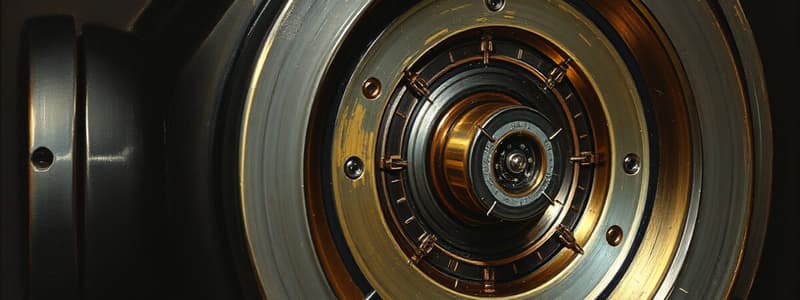Podcast
Questions and Answers
Why must a hole be drilled smaller if it is to be reamed?
Why must a hole be drilled smaller if it is to be reamed?
To allow for the metal removed by the reamer.
What determines the classification of fit?
What determines the classification of fit?
The relationship between the bolt hole and the bolt.
What is a clearance fit?
What is a clearance fit?
It is a fit that always results in a clearance when mating parts are assembled.
What is an interference fit?
What is an interference fit?
What is a transition fit?
What is a transition fit?
How is the British Standards System (BS) devised?
How is the British Standards System (BS) devised?
How is the ISO 286 devised?
How is the ISO 286 devised?
How is the American National Standards Institute (ANSI) devised?
How is the American National Standards Institute (ANSI) devised?
What are the classes of fit in the Newall hole-based system?
What are the classes of fit in the Newall hole-based system?
What is the British Standards BS 4500 system?
What is the British Standards BS 4500 system?
What is one advantage of the BS 4500 system?
What is one advantage of the BS 4500 system?
When is tolerance called bilateral?
When is tolerance called bilateral?
When is tolerance called unilateral?
When is tolerance called unilateral?
What is a shaft-based system?
What is a shaft-based system?
What is a hole-based system?
What is a hole-based system?
What is allowance?
What is allowance?
What is tolerance?
What is tolerance?
How is tolerance calculated?
How is tolerance calculated?
What is the difference between baseline and continued/chained tolerances?
What is the difference between baseline and continued/chained tolerances?
What is the Schedule of Fits and Clearances?
What is the Schedule of Fits and Clearances?
What are the four dimensions covered in wear tables?
What are the four dimensions covered in wear tables?
How are holes tested for ovality?
How are holes tested for ovality?
How are shafts tested for ovality?
How are shafts tested for ovality?
When is a shaft considered to be bowed?
When is a shaft considered to be bowed?
What are the consequences of a shaft in a bowed state?
What are the consequences of a shaft in a bowed state?
How is the amount of bow measured?
How is the amount of bow measured?
How is the amount of twist measured?
How is the amount of twist measured?
Flashcards are hidden until you start studying
Study Notes
Fits and Clearances Overview
- Proper hole dimensions for reaming: A smaller hole is required to account for metal removal by the reamer.
- Classification of fit: Determined by the relationship between the bolt hole size and the bolt size.
Types of Fits
- Clearance fit: Always results in a space between mating parts upon assembly.
- Interference fit: Always results in a tight fit between mating parts upon assembly.
- Transition fit: A compromise between clearance and interference fits, allows precise holding while remaining disassemblable.
Standards and Systems
- British Standards (BS) System: Comprises 21 types of holes (capital letters) and 21 types of shafts (small letters), covering diameters from 0.04" to 19.69", with 16 accuracy grades.
- ISO 286: Similar to the BS system but features 28 types of holes and shafts and offers 20 grades of accuracy.
- American National Standards Institute (ANSI): Aligns metric standards with ISO and uses symbols for Imperial-based measurements (e.g., RCx for running fits).
Classes of Fit
- Newall hole-based system: Class A and Class B fits; Class A offers closer tolerances than Class B.
- BS 4500 system: Standard-sized holes establish limits and various fits are achieved using shafts of fluctuating sizes.
- Advantages of BS 4500: Facilitates use of standard hole manufacturing tools like drills and reamers.
Tolerances and Systems
- Bilateral tolerance: Variation exists on both sides of the nominal dimension.
- Unilateral tolerance: One side of the tolerance is zero, focusing on the other side only.
- Shaft-based system: A fixed shaft size with varying hole sizes.
- Hole-based system: A stable hole size with varying shaft sizes.
Allowance and Tolerance
- Allowance: Difference between nominal dimensions and upper/lower limits.
- Tolerance: Range defined by extreme permissible dimensions; calculated by subtracting smallest size from largest.
Tolerance Types
- Baseline tolerances: Do not accumulate or stack.
- Continued tolerances: Cumulative and stackable.
Schedules and Testing
- Schedule of Fits and Clearances: Maintenance documentation includes tables that specify limits for wear, ovality, bow, and twist in holes and shafts.
- Wear dimension metrics:
- Dimension New: Size of the part when new.
- Permissible Worn Dimension: Size allowed before rejection.
- Clearance New: Desired clearance.
- Permissible Worn Clearance: Allowable clearance for reassembly.
Testing Methods
- Hole ovality testing: Utilizes Go/No-Go gauges, internal micrometers, or calipers.
- Shaft ovality measurement: Achieved by placing the shaft on a block and rotating it under a scribing block or dial indicator.
Shaft Conditions
- Bowed shaft: Occurs when the centerline is not straight, potentially causing vibration and mechanical failures.
- Measurement of bow: Conducted using feeler gauges or dial indicators on a surface table.
- Twist measurement: Similar process to bow, identifying twist via a dial indicator on a surface table.
Studying That Suits You
Use AI to generate personalized quizzes and flashcards to suit your learning preferences.





